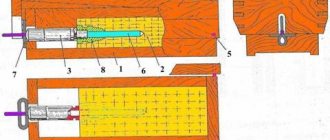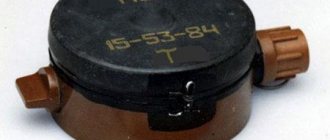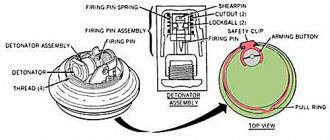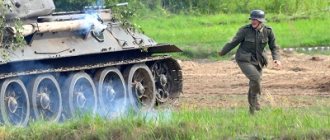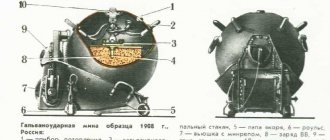How it all began
The “strange”, “sedentary” war, during which Germany captured Denmark and Norway, did not live up to its name. It was said that soldiers played football on weekends in neutral territory, and planes dropped leaflets on enemies.
In fact, during the battles in the areas between the Palatinate Forest and Saarbrücken, French scouts discovered: the enemy in impenetrable darkness unerringly finds groups and sends a fragmentation shell from very strange guns exactly to this place. Shots are not heard, flashes are not visible, only clicks, pops and explosions are heard. Death or injury of soldiers occurred from shrapnel.
This is exactly how the German novelty, Sprengmine 35, operated. The anti-personnel jumping shrapnel mine, or frog, had a circular effect. When an enemy soldier stepped on the fuse's mustache or touched the wire with his foot, after 4.5 seconds the powder charge threw the weapon 1.5 m in height.
At the end of the war, military analysts, generals, and designers were interested in aircraft and considered tanks and universal chemical weapons. According to the Versailles Agreement, the Germans did not have the right to use aircraft, tanks, or chemical weapons. In order not to violate the formalities that stipulated the number of machine guns and cannons, the defeated empire took up mines.
Sprengmine 35
Soviet and German mines
This loophole was exploited by Hitler, who adopted the Sprengmine 35 (S.Mi.35). Its design excluded the work of the miner, and the moment of action was determined solely by the victim. The Wehrmacht deployed the new weapon on the Eastern Front in 1941.
In the USSR, the OZM-152 jumping device was used. The weight of the bulky and heavy mine was 50 kg, and its length was 62 cm. Control was carried out from the remote control. Models with a tension fuse took a long time to install. Moreover, the OMZ-152 operated in conditions of concentration of enemy troops, and not on a single soldier.
Soviet designers came up with the UVK ejection chamber - it was screwed onto a projectile as a fuse. The structure was buried in the ground with its nose down. The German army has a different development - S.Mi. 44 with a universal (tension/pressure) fuse.
After the end of World War II, the German “jump” was appreciated in all countries and taken as the basis for design developments. Only in the Union were small and structurally simple OZMs of the 3rd and 4th modifications adopted. The mines were fired without shrapnel; the target was hit by fragments of the cast iron hull.
Anti-personnel mine 1972
The most powerful Soviet mine OMZ-72 was created in 1972. The blast radius of the structure was about 30 meters, and in many ways it was similar to the Sprengmine. The device, although made according to the German version, is different:
- placing shrapnel along the walls of the projectile, and not between the cylinder;
- holding the charge in the desired position with epoxy resin;
- the presence of several fuses, in particular MVE-72 with thin wire;
- ease of unwinding 15 meters of wire, which is simply placed on the ground or grass;
- actuation without tension - with a force of 300-400 g.
The most terrible fuse is NVU-P. The jumping Soviet mine is equipped with an electronic unit with a seismic motion sensor. The weapon is used in conjunction with 5 more units. When one soldier steps on a mine and is wounded, the person who rushes to his aid is hit by the next one. It is impossible to crawl out of the affected area. After the explosion of the 5th shell, there is time between connecting the second and subsequent sets.
mine OMZ-72
Interesting! The device reacts exclusively to steps - tanks and cars are not affected.
Inexpensive wins
On June 10, 1940, a new participant appeared in World War II - Italy. In Mussolini's dreams he saw himself as the hegemon of the Mediterranean, but the British interfered with him. The latter were also not happy about the appearance of a new enemy who had a large fleet.
Soon after the start of the war in the Mediterranean, the practical and cynical British neutralized the French fleet (including by attacking the base at Mers el-Kebir so that the French ships would not fall to the country).
But the Regia Marina - the Italian fleet - was a threat to Great Britain even without French ships. It dominated the Mediterranean Sea - six battleships, numerous heavy and light cruisers, a large number of destroyers and submarines made it a serious adversary.
To deprive the Italians of their advantage, a simple and effective move was needed. Carrier-based aircraft helped here. On the night of November 11-12, 1940, torpedo bombers from the British aircraft carrier Illustrious attacked the Italian Navy base in Taranto. Result: the British lost a couple of aircraft, but disabled three enemy battleships. Cheap and cheerful.
Fight in Taranto
It would seem that the job is done. The Italians were deprived of their advantage in heavy ships, and they themselves were not eager to fight the British fleet. But the British did not take into account one important nuance - the combat swimmers from the 10th MAS flotilla.
Operating principle
The bouncing anti-personnel mine is the most inhumane means of warfare. It is designed as a projectile, similar to a tin can with a deadly “filling” inside. The body is lined with two layers of balls, like bearings - with shrapnel. A charge is also placed in the “can,” which scatters shrapnel to the side. The weapon is installed in areas overgrown with grass or bushes for camouflage. This mine is triggered by snow or falling branches.
The Soviet mine acquired the name “frog” or “frog” in Afghanistan - cassettes at that time were dropped from helicopters. The green color of the can is not noticeable in the grass; under the soldier’s feet a sound is heard, like a frog being crushed. What happens next is scary to imagine.
The principle of operation of the device is based on the jumping of a projectile with an explosive filling to a height of up to 1.5 m and its subsequent detonation. The circular kill model is an effective and lethal system.
The enemy soldier is hit by its fragments when the mine is triggered. A person, touching the trip wire with his foot, activates the fuse pin. The detonator is triggered and the weapon explodes, scattering 240 balls of shrapnel or fragments of a cast-iron body at a distance of 25 meters (typical for OZM-72).
Demining of the system is carried out only during remote mining. The fuse is sensitive, so sappers do not have a second chance. As a rule, they act like a cat.
Jumping anti-personnel mine operating principle
Interesting! The second name of the frog is “Witch”.
Order to defeat
Let's start with the most important thing in a mine - the fuse. After all, if it doesn’t work on time, the power of the charge, the shock wave or fragments, the efforts of the designers and sappers will be in vain or even harm their own. On the other hand, it is the “cunning” of the fuse that makes the mine really dangerous for the enemy.
According to the principle of action, fuses are divided into contact fuses, which require direct contact with the object, and non-contact fuses, according to the timing of operation - instantaneous and delayed action. An instantaneous contact fuse “reacts” to an impact from the target, which can be touching a tensioned wire or thread (tension action), applying pressure (pressure) or, conversely, removing pressure (unloading) from the mine cover. Pull-action and push-action mechanical fuses are older but still the most common types. Combination fuses like the American M3 can use tension, push or release action.
With all modern technologies, a tripwire is still widely used - a low-tensioned wire or thread connected to the pin or lever of the fuse's impact mechanism. But the tripwire still needs to be placed and camouflaged in the grass, bushes, and garbage. In addition, the grass and branches have a habit of swaying. The target sensor can be the “antennae” (short elastic rods) of the fuse or thin threads with weights scattered to the sides of the mine. Of course, this requires a more sensitive fuse, and in order to protect the miners, it is automatically switched to the firing position only some time after the mine is installed. For this purpose, a long-range cocking mechanism is used. In remote mining systems, such a mechanism is especially important.
For proximity fuses, the target sensor can be a device that responds to mechanical or electromagnetic vibrations created by the target (or the target crossing the “beam”). Examples are a vibration or thermal sensor configured to operate above a given level, a paralaser emitter-receiver (for beam intersection), and so on. The fuse serves to directly initiate the detonation of the charge and can be part of the fuse or inserted into the mine separately when it is installed.
The fuse may include, for example, an igniter capsule, which is triggered by a puncture by a striker and detonates the detonator capsule, which in turn causes an explosion of the detonator and explosive charge. The grating fuse operates due to friction. When equipping a mine with cast TNT or ammonium nitrate explosives, an additional detonator is also required.
An electric igniter, including an electric detonator, a current source, wires and a contactor, allows the use of a wide variety of contact and non-contact circuits. For example, there may be a contact under a swinging deck board, separated by a small gap from the contact on another board. By stepping on a cover or board, the soldier will close the electrical circuit, and the fuse of a mine installed on the side of the path or flooring will be triggered. A more modern option is to have a loop of optical cable across the road. It is enough to crush or tear it so that the receiving element stops receiving the signal, and a simple electronic circuit will issue a command to detonate. The signal to the electric detonator can also come from a target sensor such as a combination of a pressure rod and a piezoelectric element, an LED-photodiode pair (the target crosses the beam), from a photosensitive sensor that responds to illumination with a strong flashlight, etc.
A number of mines are equipped with an additional detonator and a socket for a fuse to be set to non-removable - the fuse will react to an attempt, say, to move the mine or disarm it.
There are also mechanisms of self-destruction (self-detonation). An option is an electronic timer, launched simultaneously with the mine being brought into firing position. True, electronic mechanisms easily fail when power sources freeze, and at high temperatures their operation is unstable. And yet such fuses are finding increasing use. They allow you to give mines a number of capabilities at once - target selectivity (person, machine), long-range arming, self-destruction or self-neutralization (transfer to a safe position) after a given time or by a coded signal, setting to non-removable under various conditions (shift, tilt, approach of the mine detector ), the ability to “interview” mines and determine their combat status.
Types of anti-personnel mines
Developed during the First World War, the S-mine became the prototype for modern deadly modifications.
Performance characteristics of PMN mines
High-explosive pressure mines incapacitate enemy personnel, damaging the foot when the shell explodes. It occurs when the clamping cap is pressed. The limb is completely torn off; the second leg may not be affected.
PMN mine
For a land mine, an explosive type charge is used, under the influence of which a soldier loses consciousness. At high temperatures, the lower extremities can become seriously burned. A person's death occurs due to painful shock or severe blood loss.
To date, 3 types of PMN are known, presented in the table.
| Options | PMN | PMN-2 | PMN-3 |
| Weight | 0.55 kg | 0.4 kg | 0.6 kg |
| Explosive type | TNT | RDX + TNT | TNT + RDX |
| Explosive weight | 0.2 kg | 0.1 kg | 0.08 kg |
| Pressure plate radius | 55 mm | 60 mm | 61 mm |
| Pressure sensitivity | 8-25 kg | 15-25 kg | 5-25 kg |
| height | 50 mm | 54 mm | 54 mm |
| Action of self-liquidating part | — | — | from 12 hours to 1-2, 4 or 8 days |
On a note! When a high-explosive mine is detonated, one person is killed.
Performance characteristics of POMZ-2
Spring is a fragmentation mine that hits one or several fighters with fragments. Detonation occurs when a soldier touches the tripwire, thereby pulling the fuse pin.
mine POMZ-2
The tensioning device has the following performance characteristics:
| Housing material | Cast iron |
| Explosive type | TNT |
| Case weight without explosives | 1.5 kg |
| Explosive weight | 75 g |
| Case height | 13 cm |
| Case diameter | 6 cm |
| Damage radius | 4 m |
| Type of lesion | Solid |
| Sensitivity | 1-17 kg |
| Sensor chain length | 4 m one way |
| Temperature range of use | from −60 to +60 degrees |
On a note! Installation is carried out with one or two branches of wire.
Performance characteristics of MON-50
The enemy soldier is hit by lethal elements flying out at an angle of 54 degrees. The height of the lesion near the device is 15 cm. The maximum range is 4 m. Fragmentation mines are installed on the ground using legs or clamps, similar to a photo tripod, and can be attached to various surfaces.
Detonation is carried out by the operator from the control panel or the soldier himself, touching the break or tension sensor of the fuse. The only weapon in the line of mines that can cause damage to infantry troops and light vehicles. It has the following performance characteristics:
| Type | Directional fragmentation controlled |
| Housing material | Plastic |
| Defeat | From 485 steel rollers or 540 steel balls |
| Weight without charge | 2 kg |
| Charge type | PVV-5A |
| Charge weight | 0.7 kg |
| Length | 22.6 cm |
| Height without legs | 15.5 cm |
| Control type | Electric pulse from the remote control |
| Chain sensor | Precipitous |
| Range | 50-58 m |
| Action height | 4 m |
| Activation force | 300 g |
On a note! The weapon is supplied complete with a mine, a detonator bushing, 2 bushings for attaching the electric detonator, clamps, and a canvas transport bag.
German mine S.Mi.35
Some sources call the device, designed in 1935, the Schrapnell-Mine 35, but the name Sprengmine has become popular. The jumping land mine is the prototype of all modifications of the circular blast. Its main part is a projectile that is thrown up, explodes and hits the enemy.
German mine S.Mi.35
Design
The unit includes several parts:
- a bottom with ring grooves for inserting two thin-walled metal pipes - outer (large) and inner (small);
- shrapnel - steel balls (320-365 pcs.), which fill the space between the pipes;
- cover - installed on top of the body;
- central tube - screwed into the bottom, secured with a nut and connects all the components of the mine.
The smaller tube contains the explosive, and 3 ignition tubes with fuses are screwed into the bottom of the projectile. At the bottom of the bottom there is a powder charge of expelling action. At the top of the central tube you can screw 1-2 tension fuses.
German mine S.Mi.35
How does the S.Mi.35 mine work?
The mine that the Germans invented is called a frog for a reason: you can consider its principle of operation using the example of a mechanism with a S.Mi.Z.35 fuse:
- The device is buried in the ground so that only part of the fuse is visible.
- An enemy fighter steps on the tendrils of the fuse, the rod goes down, releasing the stopper balls, and the firing pin hits the primer.
- The flame is forced to the central pipe, igniting the powder retarder below. It burns for 4.5 seconds.
- An enemy soldier leaves the mine.
- The moderator ignites the expelling powder charge - it throws the frog 1.5 m and at the same time ignites the moderators in the ignition channels.
- When the mine flies upward, the flame from the dying retarders enters the fuses, which explode and hit the victim.
Interesting! For effective operation, one ignition tube is enough, but the Germans decided to duplicate the mechanism.
Performance characteristics of the S.Mi.35
The German Sprengmine has the following tactical and technical indicators:
| View | Shrapnel circular damage |
| Housing material | Metal |
| Explosive type | Black powder |
| Weight without charge | 4-5 kg |
| Blast charge weight | 180-450 g |
| Number of shrapnel balls | 320-365 pcs. |
| Case height | 12.8 cm |
| Case diameter | 10.2 cm |
| Sensor sensitivity | 2-5 kg - push |
| 3-5 kg - tension | |
| Single sensor length | 16 m |
| Fuze types | ZZ 35, S Mi Z 35, S Mi Z 44, Zu ZZ 35, ES Mi Z 40, ZZ 42, DZ 35 |
Interesting! V. Fleischer talks about the name of the mine Schuetzenmine 35. The Soviet-era reference book “Enemy Mine Demolitions,” published in 1943, states that frogs were used as guided weapons.
Raid on Alexandria
On the night of December 19, the Italian submarine "Shire" of Prince Valerio Borghese at minimum speed carefully crawled to Alexandria Bay and fired trimaiale "(human torpedoes): each carrying two saboteurs and 270 kg of TNT. When they approached the entrance to the harbor, it was open! The British removed booms and net barriers for the passage of returning cruisers and destroyers
Slipping into the harbor, the saboteurs headed towards the battleships Valient, Queen Elizabeth and a naval tanker. Lieutenant de la Penne's torpedo went towards Valient." But his partner Emilio Bianchi lost consciousness and slid off the torpedo. The lieutenant had to put the charge under the battleship himself. As British researcher David MacIntyre wrote:
With superhuman efforts, wandering almost blindly in a cloud of silt, de la Penne managed to do it! He triggered the fuse's clockwork and floated to the surface."
The lieutenant reached the battleship's mooring barrel, where he found Bianchi. At 03:25 they were spotted by the British and brought on board. The Italians were interrogated, but they refused to answer questions. Only at 06:00 did de la Penne inform Valiente’s commander that the ship was mined and would soon explode.
The two remaining crews of Mayale successfully placed charges under Queen Elizabeth and the tanker Sagon. They managed to get ashore, but were soon arrested by the police. The first pair of saboteurs were captured immediately in the harbor. The second managed to get out of the city, but was caught after she began paying in British pounds, which were not used in Egypt.
At 05:47 an explosion was heard under the tanker. At that moment, four destroyers were refueling from it. One of them, Jervis, was seriously injured.
At 06:06, the charge installed by Valient went off.” Four minutes later it exploded under the bottom of Queen Elizabeth.” Both battleships sank to the bottom of the harbor and were disabled for a long time.
Performance characteristics
In Russia, the OZM-72 model was adopted for service in 1973. It was used during the Afghan campaign, and Uzbekistan has been placing “frogs” on the border with Tajikistan since 2000. As of 2016, the Russian weapons arsenal included a large number of anti-personnel mines with the following characteristics:
| Type | Fragmentation barrage or anti-personnel circular destruction |
| Housing material | Steel |
| Weight | 5 kg |
| Explosive type | TNT |
| Explosive Component Weight | 660 g |
| Defeat | 2400 steel balls/rollers |
| Case height | 17.2 cm |
| Case diameter | 10.8 cm |
| Sensitivity | From 1 to 17 kg |
| Radius of action | 25 m |
| Fuse type | MUV-3, MUV-4, MUV-2 - without fuse |
| MVE-72, MVE-NS - with fuse | |
| Fuse type | Capsule with detonator |
| Target sensor | Break/tension |
On a note! The target sensor is selected according to the type of fuse.
Explosion and fragments
Most mines consist of three main elements - the explosive charge, the fuse and the casing.
The action of any mine is based on an explosion, that is, an extremely rapid release of a large amount of energy, accompanied by the emergence and propagation of a shock wave.
The explosive transformation propagates through the mass of a conventional explosive (explosive) either by heat transfer and radiation released during combustion, or by the mechanical action of a shock wave propagating through the mass of the explosive at supersonic speed. In the first case, the process is called combustion, in the second - detonation.
Depending on the application, explosives are divided into: initiating (intended to initiate explosive processes), high explosive or crushing (used for destruction), propellant, pyrotechnic compositions.
Mines for various purposes mainly use high explosives that are sensitive to detonation. These include organic chemical products such as TNT, tetryl, hexogen, PETN, plastid and others, as well as cheap ammonium nitrate explosives (ammonites). Pyrotechnic compositions are used, for example, in signal and incendiary mines.
But the energy of the explosion must still be used to defeat the enemy. Mine-explosive injuries are usually combined, caused by several factors at once, but two main ones are distinguished - fragmentation and high-explosive damage.
The high-explosive effect consists of hitting the target with hot high-speed explosion products at close distances, and then with excess pressure in the front and the high-speed pressure of the shock wave. Even a slight excess pressure of 0.2-0.3 kg/cm2 can cause serious damage. A high-explosive mine explosion is usually associated with the separation or destruction of a limb, damage to internal organs, great vessels, and nerve columns.
As for fragments, a fragment is considered lethal when it encounters a target with a kinetic energy of about 100 J. This means that a steel fragment weighing only 0.13-0.15 grams with a speed of 1,150-1,250 m/s can be considered lethal. . A heavy fragment of irregular shape, of course, causes great tissue destruction, but the shock inflicted on body tissues at low speed is less. In addition, the fragment must still hit the target, and since the explosion is “non-targeted,” it is better to “have more fragments.” If at a certain distance from the point of explosion at least half of the targets (and the target is a human figure, approximately 1.5-2 by 0.5 meters) “receive” 1-2 lethal fragments, this distance is called the radius of effective destruction, if not less than 70 % - complete destruction (although in descriptions of fragmentation mines one can find confusion in these radii). Shrapnel wounds are usually penetrating; if the fragments are irregularly shaped, they can also be torn, with severe damage to internal organs, rupture of blood vessels and nerve tissue, and bone fractures. Ready-made spherical fragments, used in a number of mines, leave small channels in the body, but “ball wounds” are characterized by multiplicity. The steel ball in the tissues of the body moves along a unique trajectory, abruptly changing directions, the wound has numerous blind channels, and is accompanied by ruptures of internal organs.
Methods of application
This mine is placed singly, as a trap, or used to create minefields.
Minefield
The installation of anti-personnel mines is carried out in the form of a field with good visibility for one’s troops. Soldiers can shoot through fields, excluding enemy passages. In case of a counterattack, they leave passages for their personnel.
A minefield is intended for field or long-term fortification, often combined with barriers. The cluster includes frogs and anti-tank mines, which are used to delay the enemy and cause damage to soldiers and military equipment.
Single installation
Laying mines is done manually, activation is done from the control panel or when pressed with the foot. Terrorists and partisans use similar equipment when their troops retreat. They are also deployed by intelligence services and criminal structures for the purpose of murder, terrorist attacks or elimination operations.
Interesting! The Germans used surprise mines disguised as souvenirs. They were often dropped by Luftwaffe squadrons along with leaflets.
Creeping Enemy
In many countries of the world, dozens of samples of jumping mines have been developed: from the simplest to “intelligent” ones, which are not only able to distinguish the movement of a person from the movement of an animal or machine, but are also able to distinguish their own soldier from someone else’s and react accordingly.
Moreover, there is information that crawling mines have been developed that communicate with each other, determine unaffected places in the minefield and themselves move accordingly to the desired points. It is interesting that similar developments are being carried out in the countries that initiated the creation of the Ottawa Convention on the Prohibition of Anti-Personnel Mines. The creators' argument is simple - these are not mines, these are ammunition of a completely different type, and the convention does not apply to them.
The article was published in the magazine “Popular Mechanics” (No. 4, April 2005).
Ban on anti-personnel mines
The UN has recognized bouncing mines as inhumane weapons that damage the enemy’s psyche. The ban on these anti-personnel weapons was carried out several times:
- in 1992. Six non-governmental organizations founded the International Movement to Ban Landmines. Among the participating countries are the USA, India, Pakistan, China, Russia, Israel;
- in 1997. The Mine Action Foundation was founded in Switzerland. He is engaged in the search and neutralization of unexploded weapons;
- in 2006 year. The UN established the International Day of Mine Awareness and Assistance in Mine Clearance. The action allows us to draw attention to the deactivation of unexploded weapons and the ban on the use of “frogs”.
Interesting! In 1997, the Ottawa Convention was adopted. Ratification banning the release, stockpiling, use and sale of anti-personnel mines has been signed by 111 states, but they implement it only formally.
"Frog People"
The first time Italian underwater saboteurs made themselves known was on November 1, 1918, when they sank the battleship Viribus Unitis.” But the war was already ending, so Rome was not particularly involved in the development of such special units
They drew attention again only before World War II
During this period, special forces naval units were created in many powers. The USSR did not stand aside either.
In 1939, the 1st assault flotilla of combat swimmers appeared in Italy. In March 1941, it was transformed into the tenth flotilla MAS (Mezzi d'Assalto - assault weapons) - and it was under this name that it became famous. The saboteurs were to attack Royal Navy bases in the Mediterranean. First of all - in Gibraltar, Malta and Alexandria.
His Majesty's ShipYork"
But the first success was achieved in the Cretan bay of Souda. There, exploding boats severely damaged the British heavy cruiser York, forcing her to run aground. The British were unable to save it - the ship was finished off by German dive bombers. A tanker was blown up there. And in September 1941, underwater saboteurs attacked Gibraltar, where they sank three transports.
The British knew about their existence. They even captured several swimmers, including the pilots of the boats that blew up York.” Security at anchorages has been seriously strengthened.
But fortune sometimes doesn’t care about any precautions. It was luck that helped the Italians penetrate the harbor of Alexandria, where their actions turned out to be a disaster for the British fleet

